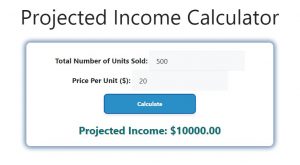About Projected Income Calculator (Formula)
The Projected Income Calculator is an invaluable tool for businesses and entrepreneurs looking to estimate their potential revenue. By providing a clear picture of expected income based on sales forecasts, this calculator aids in strategic planning, budgeting, and financial management. Understanding projected income can help businesses make informed decisions about resource allocation, marketing strategies, and overall growth.
Formula
The formula for calculating Projected Income is:
Projected Income (PI) = Units Sold * Price Per Unit
Where:
- Units Sold refers to the estimated number of products or services expected to be sold within a given time period.
- Price Per Unit indicates the selling price of each product or service.
How to Use
Using the Projected Income Calculator is straightforward. Follow these steps:
- Estimate Units Sold: Analyze past sales data, market trends, and demand forecasts to determine the number of units you expect to sell.
- Determine Price Per Unit: Set the price for each unit of your product or service, considering factors such as production costs, market rates, and competitor pricing.
- Input Values: Enter the estimated units sold and the price per unit into the calculator.
- Calculate Projected Income: Multiply the number of units sold by the price per unit to obtain the projected income.
Example
Let’s say a business anticipates selling 500 units of its product, priced at $20 per unit.
Using the formula:
Projected Income (PI) = Units Sold * Price Per Unit
Projected Income (PI) = 500 * 20
Projected Income (PI) = $10,000
In this example, the projected income is $10,000 for the given period.

FAQs
- What is a projected income calculator?
A projected income calculator estimates future income based on expected sales and pricing. - Why is projected income important?
It helps businesses forecast revenue, plan budgets, and make informed financial decisions. - How accurate are projected income calculations?
Accuracy depends on the quality of sales estimates and market analysis. It’s important to regularly update projections. - Can I use historical data for projections?
Yes, historical sales data is a great starting point for making accurate projections. - What factors influence units sold?
Factors include market demand, marketing efforts, seasonality, and competition. - How do I set the price per unit?
Consider production costs, market rates, and competitor pricing to determine the best selling price. - Is the projected income calculator applicable to all businesses?
Yes, any business that sells products or services can use this calculator. - Can I project income for multiple products?
Yes, you can calculate projected income for each product separately and sum them for total income. - What if I expect fluctuations in sales?
You can create multiple scenarios (best case, worst case) to account for potential fluctuations. - How often should I update my projections?
Regular updates are recommended, especially after significant changes in the market or business operations. - Can I use this calculator for service-based businesses?
Absolutely! Just replace units sold with the number of service hours or packages expected to be sold. - What is the difference between projected income and actual income?
Projected income is an estimate, while actual income reflects real sales achieved. - How can I improve the accuracy of my projections?
Use comprehensive market research, historical data, and consider economic factors that could impact sales. - Is there a limit to how far in advance I can project income?
While you can project income for any future period, the accuracy tends to decrease as the time frame extends. - What tools can I use to analyze past sales data?
Tools like spreadsheets, accounting software, or CRM systems can help analyze sales history. - Can I incorporate expenses into the projected income calculation?
This calculator focuses on income, but you can create a separate calculation for expenses to assess profitability. - What are common mistakes to avoid when using this calculator?
Common mistakes include overestimating sales, ignoring market trends, and neglecting to adjust for seasonality. - Can I use this calculator for non-profit organizations?
Yes, non-profits can use it to project income from fundraising activities or service offerings. - How do I interpret negative projected income?
Negative projections indicate that expenses may exceed expected revenue, prompting a review of pricing and sales strategies. - What should I do if my projections aren’t meeting actual sales?
Re-evaluate your assumptions, analyze market conditions, and adjust your sales strategies accordingly.
Conclusion
The Projected Income Calculator is a powerful tool that enables businesses to forecast their revenue effectively. By estimating units sold and setting the price per unit, organizations can gain insights into their financial future. Regularly updating projections based on market conditions and sales data is essential for maintaining accuracy and making informed decisions. Whether you’re a startup or an established business, understanding projected income is crucial for strategic planning and growth.